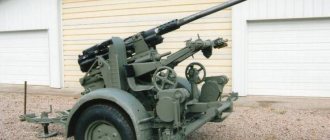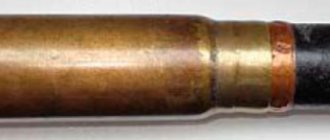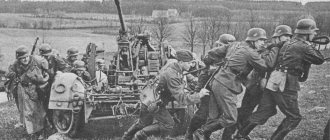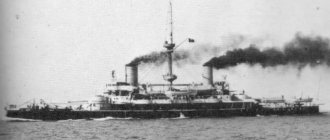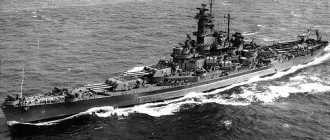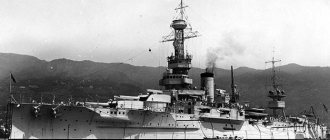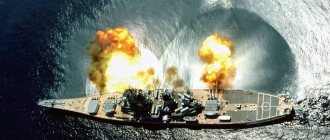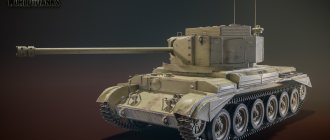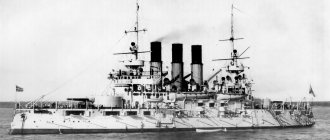Battlecruisers and battleships of England
By 1927, the British fleet consisted of up to one and a half dozen battleships and battlecruisers. The newest of them were the "Nelson" and "Rodney" with a displacement of 34,000 tons, capable of reaching a full speed of up to 23 knots. For the first time in the world, they were equipped with nine 406 mm guns, located in three gun turrets and the bow of the ship. There were no main caliber guns in the stern. Anti-aircraft weapons included six 120 mm cannons and 18 machine guns. These were great WWII British ships.
10 battleships of the Queen Elizabeth and Royal Sovereign class were built during the First World War. Their displacement was 30,000 tons, and their full speed was 22-25 knots. The main caliber consisted of eight 381 mm guns, the universal caliber consisted of twenty 114 or twelve 152 mm guns. The battlecruisers " Rinaun " and " Repulse " with a displacement of 32,200 tons were armed with six 381 mm guns and reached a speed of up to 29 knots.
A special place was occupied by the battle cruiser Hood. Its main weapon corresponded to that of a battleship - eight 15-inch guns, and in terms of displacement (42 thousand tons) and length (262 m) it was the largest warship in the world. Full speed reached 31 knots. Its construction cost English taxpayers 6 million pounds sterling. Unfortunately, Hood's defensive qualities turned out to be low. As already mentioned, in May 1941, the Hood was sunk in the fifth minute of the battle by the fire of the 15-inch guns of the German battleship Bismarck. Two shells pierced three armored decks of the Hood and reached the cruiser's powder magazine.
Battleship King George V
Shortly before the start of World War II (1937), the British laid down, and in the first years of the war commissioned, the battleship King George V, Prince of Wales and Duke of York with a displacement of 35,000 tons with ten 356 mm guns . They were created as a counterweight to the German Scharngorst. At lower speeds, English battleships carried more powerful artillery and more solid armor.
Battleship Royal Oak
In 1942, the British fleet was replenished with two more of the same battleships - Anson and Howe . Unlike pre-war battleships, they had increased survivability, more powerful and automated anti-aircraft weapons, and were equipped with radar stations for detecting and controlling weapons. The side of the ship was protected by armor 406 mm thick, the main deck - 200 mm.
Nowadays, English historians condemn the Admiralty for leaving five old slow-moving battleships of the Royal Sovereign type in the fleet. “Retiring them from the fleet and building two or three aircraft carriers in their place would be of great benefit,” writes historian S. Roskil.
Collect the perfect branch. Battleships of Britain
Date: 11/14/2016 | Posted in Community | |
We are starting a new section dedicated to forecasts and vangs. We promise it will be interesting and logical. But it’s not a fact that they will do exactly this in the game, because the logic of “Lesta” is by no means always the logic of ordinary people.
Actually, there are no plans to go too far into the future; the emphasis will be on relatively nearby (and adjacent) branches.
And we’ll start with a branch that, in one form or another, will most likely become the next one, after German destroyers, to be introduced into WoWs. Namely, British battleships (or battlecruisers).
Why this particular thread? The community is hungry for more battleships. Well, more British. And British battleships are also numerous and epic. And you can’t introduce aircraft carriers without battleships (and people are already waiting for new aircraft). Plus, the pause between the German and British battleships will be quite wow, almost a year. Well, another year of Jutland. Therefore, we can say that this thread will be released before the end of spring 2022.
Next we will look at who is more epic, battleships or battlecruisers. It is worth noting here that both of them are very worthy and interesting. Therefore, we will list the pros and cons separately.
Battleships
pros
A) huge (no, seriously huge) caliber. Big alpha, big breakdown
B) Level 6 of the branch is already in the game. Repaint and slightly reconfigure Warspite and Queen Elizabeth is ready for battle.
C) together with the branch, you can launch prem-8 (more about it below).
D) Monstrous firepower, perfect for destroying enemy battleships
D) Easy to learn technique that will appeal to the masses
E) A logical and reasonable feature without elves fucking land mines. Increased (due to caliber and alpha) chance to crit enemy module
Minuses
A) Stupid ballistics
B) Rate of fire
B) Terrible accuracy
D) Often low speed
D) Melee battleships-2. Some went well, no doubt. But is another one too early?
E) Narrow scope of application in combat. Excessive caliber interferes in the fight against destroyers and cruisers, helplessness in the fight against aircraft carriers
Battlecruisers
pros
A) A new type of ship in battles, new spaces for tactics
B) Wider possibilities for use in battles
B) Excellent for destroying cruisers, a difficult target for aircraft carriers
D) Still a large caliber
D) High speed
Minuses
A) Another class “not for everyone.” And again British
B) The non-obviousness of the branch’s “feature”
C) In the end we still get a battleship
D) Helplessness in the fight against battleships, vulnerability from destroyers
D) Still poor rate of fire
E) Still terrible ballistics
As you can see, the choice is from two equal and interesting branches, in which there are plenty of interesting ships. But I dare to suggest that the classic battleships that will become direct competitors to the “Germans” will still be captured. Well, the battlecruisers will arrive in a year or a year and a half. Although you can argue with me in the comments.
So, let's look at both* branches separately. Not only did Britain build battleships eagerly, it was also the first to build such a ship. Ironically, the latter too. You can forget everything you knew about large caliber. Alpha males, ogres with a club, English psychos - this is just about battleships. And if the German battleships became close combat ships largely because of their protection, in some places torpedoes and equipment, then the British are betting on a huge breakdown, alpha and low accuracy (but at the same time a good PTZ would be logical). General? Unless it's a good PMK.
* It’s worth noting that there are two lines of battleships. But the second one will be much more similar to the ships already in the game, so we are going from caliber.
Level 3
Dreadnough
The ship that created a class that influenced everyone and everything. Of course, there can be no other choice. 10 guns (8 on board) of 305 mm caliber, almost 22 knots of speed. Simply put, the fastest, and the most armed (on a par with Kavain and Carolina and almost always on the level of Koenig Albert).
Level 4
Orion
305 mm is no longer enough. Meet 343 mm. These are not “Kaiser-Wyoming-Ishizuchi” 305, but also not 356, like Mega’s. And again 10 guns. But all 10 can now fire from the side. Minuses? Perhaps there are almost none. The speed of 21 knots is greater than that of Vayo, the armor is plus or minus at the same level (the front of the turrets and the wheelhouse are slightly less protected). Therefore, obviously, the rate of fire and secondary guns will suffer (which is historically justified).
Level 5
Actually, it is level 5 that raises the greatest number of questions. There are a lot of well-deserved candidates here. However, Iron Duke and King George (1911) are armed with the same 343. And 343 mm at level 5 is worse than both the Japanese and the American. And we want to be better (or no worse). Therefore...
Canada
Yes, these ships were built for Chile. Yes, one eventually got there, having first served the Crown. Yes, the second one actually became an aircraft carrier (although both of these are rather advantages, because you can make prem and avik for the branch). Characteristics? Actually, 5x2 356mm guns. The British were very fond of an even number of guns in the tower. Koenig is far behind due to caliber, Kongo is behind due to the fact that it is a battlecruiser. New York is holding on for now. However, the American only dreams of 23 knots. This turns out to be the most balanced battleship at the level. The price, again, is the rate of fire.
Level 6
Queen Elizabeth
There's not much to say about this ship. It is already in the game as a premium. The accuracy of the 381 mm guns (4x2, in case anyone has forgotten), of course, is not very good, but it is POWERFUL. And yes, 25 knots is no longer a fountain at level 6, but still acceptable.
Level 7
Nelson
The picture shows a sistership. The main ogre of the entire branch. If it hits, it won’t just hurt, it’ll hurt terribly. Moreover, even big guys from level 9. 23 knots, but 3x3 406 mm. 406 millimeters at level 7, Karl! Spraying destroyers into atoms if they are hit by landmines is included. The ideal battleship hunter. If not for one (okay, two) “but”: speed from Colorado and accuracy from a blind alcoholic. Well, yes, it will be difficult to kill cruisers, they are overpowered everywhere (or even overpowered in Congo, which, for a second, is a battle cruiser).
Level 8
King George V, Prince of Wales
Here the question arises: “but why? Georgi has 356 mm!!” The answer is both yes and no. During the development of ships, there were a lot of projects that included options with both 381 mm and 406 mm. The Historic Prince of Wales (2x4, 1x2 356mm) follows in Prem-8. Such a “Scharnhorst” for yourself. And on, in fact, Georg, the 406 caliber is fitted, maintaining continuity in the branch. There are options for towers: 5x2, 4x2, 2x4+1x2, 3x3, 2x3+1x2. In general, to your taste. Speed 29 knots. This is more than the Mink, but less than the Germans and the Japanese.
Level 9
Temereire
Aka "Lion" (but the name is reserved for battlecruisers). He is the Crown’s real wish list, which was never completed in the end. 3x3 406mm, 30 knots (slower than Iowa, but at the same level as Friedrich and faster than Izumo). There seems to be no point in going into close combat: either the secondary gun will be spat on or the Japanese “monster of happiness” will fly in. If before this the British beat the German card with an attack, then at level 9 the game designers will have to think. To be honest, I couldn’t think of anything other than relegating this craft to medium-range rather than close-range battleships.
Level 10
Wet Wishlist
Obviously, this is where anything planned after Lion or Vanguard should land. But there is no exact data on British Wishlist. Yes, paper. There is another option called N3, which has roots going all the way back to the Washington Agreements. Yes, he's a good devil, for sure. 3x3 457mm. Almost Yamato. But it's very old. And “Temeraire” is about something completely different. So, either look for another napkin or look for a napkin at level 9, and at 10 to modernize the old 1922 want.
Battlecruisers
Everyone understands that the trump card here will not be armor, but firepower and speed. There are also questions about the ability to “take off” in random.
Level 3
Invincible
4x2 305mm, 26 knots. There are 6 barrels in a broadside salvo (8 in a narrow sector). Apart from the lack of armor and firepower in favor of much greater speed, there is nothing to say.
Level 4
Lion
4x2 343mm, 28 knots. The speed has already increased (the same as that of the Japanese), the firepower has already increased (still lower than that of the Ishizuchi). The broadside is already full, but the dead zones are still large. Compensation is an even higher rate of fire.
Level 5
Tiger
4x2 343mm, 30 knots. The race with the Japanese continues. The speed is similar to the Kongo, but the weight of the salvo is lower (despite the fact that the Briton was built taking into account the experience of building the Japanese). In general, it will shoot often, but it won’t hurt as much as the Japanese.
Level 6
Renown
3x2 381mm, 30 knots. The only comparison can be made with Dunkirk. But bad luck, the Frenchman is 20 years younger and has 8 guns located in his nose. It turns out that their small caliber and the weakness of the side protection do not play such a big role. But it will be very difficult for “Rinaun” to shoot without getting half a face in response (after all, we remember that 381 caliber is by no means the most accurate at level 6).
Level 7
Hood
The crowning achievement of the development of IRL battlecruisers (except for the strange vysery of the USA during the war and the USSR after it). 4x2 381mm, 32 knots. And a couple of torpedo tubes on board (4 three-torpedo tubes in total). The ship is famous, honored, ridiculed (and itself ridiculed “Dunkirk”). The pros and cons are obvious - firepower is no worse than that of battleships (and better than that of the Gneisenau), speed is at the top, protection... there is none. Obviously, the Hood will be a very interesting ship to use, constantly on a knife's edge.
Level 8
By building the Hood, the British satisfied their insatiable hunger for building battlecruisers. His descendants did not go further than IRL projects.
There are two options for the development of events for the game. The first is three napkins. J3, G3, I3, respectively. 3x3 381mm, 3x3 406mm, 3x3 457mm, respectively. Well, the speed is about 30-33 knots. Plus? The entire branch is made up of ships of the same type. Minus? Well, there are too many wishes.
Option two. Transition to battleships. Plus – the historicity of this method and the iron ship at level 8. The downside is that the orderly evolution of the class has been destroyed. In the author's opinion, the options are equivalent.
Vanguard
The last world battleship built. 4x2 381mm, 30-32 knots. The weakness of the weapons should not deceive: if the Bismarck trumps the secondary battery, then the Venik could easily trump the air defense (you can also issue a barrier).
Levels 9-10
Wet wishes of Corona
The next article in the series will be devoted to Soviet destroyers. Or rather, their division into two branches.
Author of the publication
offline 2 years
ex_it
Comments: 5509Publications: 659Registration: 02-10-2016
Real and present threat
Mitchell's experience was never confirmed in the future. Having repeatedly attacked battleships at sea, the bombers did not sink any of them in combat conditions. It’s a different matter if torpedo bombers attacked along with them.
The birth of torpedo-carrying aircraft occurred before the First World War. And already during the war, torpedo bomber planes made their first successful attacks, establishing themselves as a formidable weapon. The further development of this type of naval aviation in the interwar period was associated with the emergence of aircraft carriers. Thanks to them, torpedo bombers could operate without being tied to airfields on land, flying on missions directly from the ship’s deck.
Raid on Taranto: how torpedo bombers defeated battleships
Particular attention was paid to the construction of aircraft-carrying ships in Japan, the USA and Great Britain. But it was the British fleet that was the first to use aircraft carriers in a combat situation, and it was their torpedo bombers that inflicted the first defeat on battleships. On November 12, 1940, Admiral Andrew Cunningham's squadron carried out Operation Punishment, the purpose of which was to destroy the main forces of the Italian Navy at the Taranto base. Torpedo bombers launched from the aircraft carrier attacked Mussolini's ships right at their anchorage. Unprepared to repel the raid, the Italians paid dearly for their carelessness. British pilots managed to disable three enemy battleships at the cost of only two downed aircraft.
The success of the raid on Taranto attracted the attention of naval specialists from other countries. Japan carefully studied the British experience and subsequently reproduced it by attacking Pearl Harbor on December 7, 1941. Then Admiral Nagumo's carrier force launched a surprise attack on the American Pacific Fleet, causing serious damage. As a result of a combined raid by Japanese bombers and torpedo bombers, eight battleships were disabled, two of them permanently.
The attacks on Taranto and Pearl Harbor showed how vulnerable a battleship at anchor was. However, between these events there were two successful torpedo attacks on battleships at sea. The first case took place on March 28, 1941 during the battle of Cape Matapan. Then aircraft from the British aircraft carrier Formidable managed to hit the Italian Vittorio Veneto with a torpedo. In the second case, the British again distinguished themselves. On May 26, their torpedo bombers from the aircraft carrier Ark Royal hit the German Bismarck.
Battle of Matapan: how the British defeated Mussolini's fleet
The consequences of the mentioned attacks varied. The torpedo explosion caused the Vittorio Veneto to slow down, but did not deprive it of its speed. Therefore, the “Italian” managed to independently reach the base, eluding the British squadron. Bismarck was less fortunate: a torpedo disabled her steering. After this, the ship was doomed and was lost the next morning in a battle with British ships.
Although these attacks showed the threat that torpedo bombers posed, the aircraft involved still failed to sink battleships on the high seas. But trouble has begun. We didn’t have to wait long for a different result.
British aircraft carrier Ark Royal and its torpedo bombers
United Kingdom Government/Wikimedia Commons
